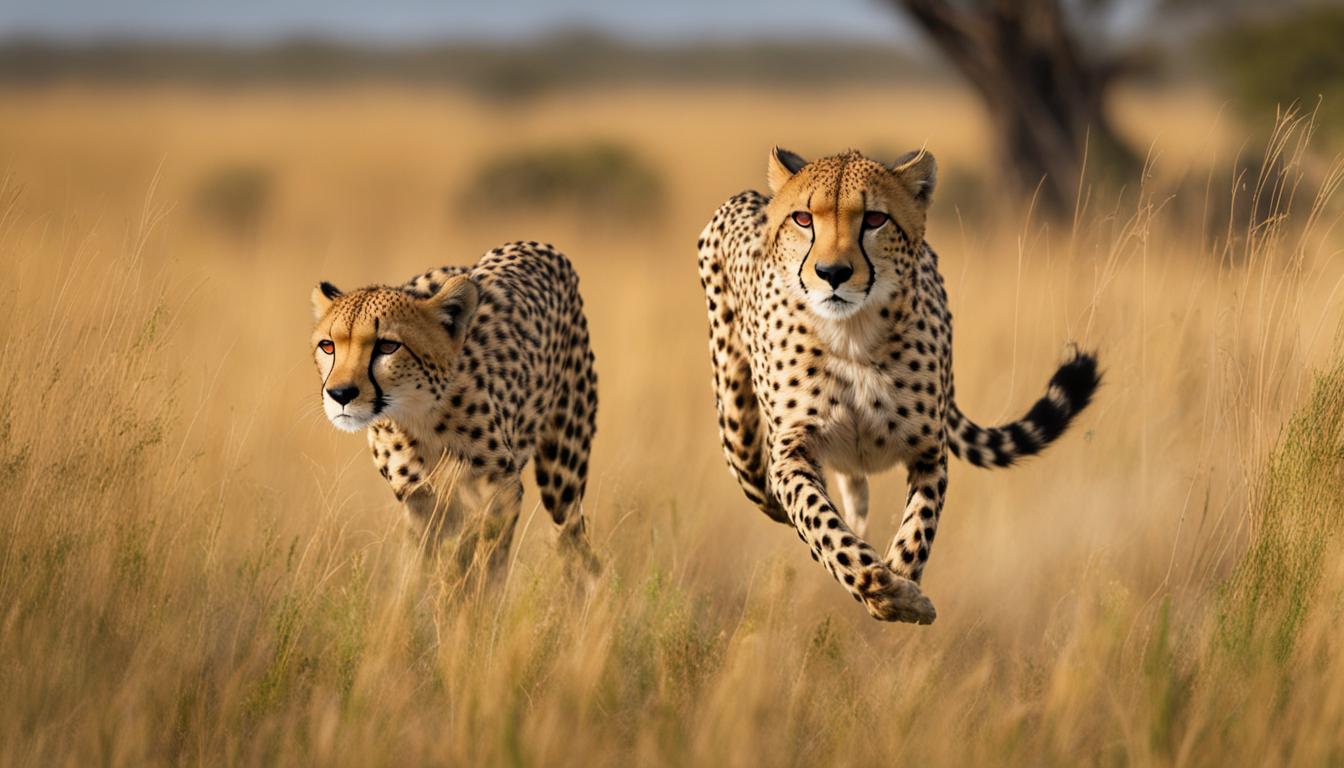The cheetah population has significantly declined over the years, making it one of the world’s most endangered species. There are currently only 12,000 to 15,000 cheetahs left in the wild, residing in two dozen countries. The main threats to these majestic animals include loss of habitat, poaching, and conflicts with livestock farmers. However, several key conservation efforts are being implemented to protect cheetahs and ensure their survival. These efforts focus on habitat restoration, the involvement of local communities, the use of guardian dogs to mitigate human-wildlife conflict, and collaboration with other conservation organizations.
By working together, we can make a difference in cheetah conservation. Stay tuned to learn more about the holistic conservation strategies, guardian dogs, collaboration with conservancies, habitat restoration, and sustainable energy initiatives that are helping protect the cheetah population and preserve their natural habitats.
Holistic Conservation Strategy for Cheetah Conservation
The Cheetah Conservation Fund (CCF) follows a holistic conservation strategy to save the cheetah and its ecosystem. By addressing both wildlife populations and the concerns of human communities, CCF ensures that conservation efforts benefit the entire ecosystem upon which the cheetah depends.
One aspect of CCF’s holistic approach is their conservancy initiatives. These initiatives aim to promote responsible wildlife management and habitat protection. Through partnerships with landowners and local communities, CCF helps create sustainable conservation areas that benefit both wildlife and people.
In addition to conservancy initiatives, CCF is involved in biomass technology development. This research and development project focuses on restoring cheetah habitat by transforming overgrown thorn bush into high-heat, low-emission fuel logs. This not only aids in habitat restoration but also provides a sustainable alternative fuel source for local communities.
Furthermore, CCF is committed to livelihood development for the communities that share the cheetah’s habitat. By providing economic opportunities and promoting sustainable livelihoods, CCF ensures that local communities have a vested interest in protecting the cheetah and its ecosystem.
Conservancy Initiatives
CCF’s conservancy initiatives play a crucial role in the holistic conservation strategy. These initiatives involve working with groups of landowners to responsibly manage wildlife and their habitats. Through the establishment of conservancies, local communities become actively involved in wildlife protection and conservation efforts.
Conservancies governed by responsible landowners are more resistant to poaching and other illegal activities. They provide protected areas for wildlife populations, including the cheetah, to thrive. Additionally, conservancies often bring economic benefits to the communities through wildlife-based tourism, creating incentives for communities to prioritize conservation.
Cheetah Conservation Fund (CCF) follows a holistic conservation strategy that addresses both the needs of cheetahs and their ecosystems. By focusing on conservancy initiatives, biomass technology development, and livelihood development, CCF ensures the long-term survival of cheetah populations and promotes ecosystem health.
One of the core elements of CCF’s strategy is their conservancy initiatives. These initiatives involve collaboration with landowners and local communities to establish and manage conservancies that prioritize wildlife conservation and habitat protection. By encouraging responsible wildlife management and sustainable land use practices, CCF aims to create a balance between wildlife conservation and community development.
In addition to conservancy initiatives, CCF is actively involved in biomass technology development. Through their Bushblok program, CCF transforms overgrown thorn bush into fuel logs. This not only helps restore cheetah habitat by reducing encroachment but also provides a sustainable fuel source for local communities. By addressing both ecological and economic needs, CCF’s biomass technology contributes to cheetah conservation and community well-being.
CCF also recognizes the importance of livelihood development for the communities that share the cheetah’s habitat. By providing training and support for alternative livelihoods such as eco-tourism and sustainable agriculture, CCF helps communities become economically self-sufficient while reducing their reliance on activities that may harm wildlife. This integrated approach ensures that cheetah conservation efforts align with the needs and aspirations of local communities, promoting long-term sustainability.
| Key Elements of CCF’s Holistic Conservation Strategy | Benefits |
|---|---|
| Conservancy Initiatives |
|
| Biomass Technology Development |
|
| Livelihood Development |
|
Utilizing Anatolian Shepherd and Kangal Dogs for Cheetah Protection
One of the key strategies employed by the Cheetah Conservation Fund (CCF) to protect cheetahs is the utilization of Livestock Guarding Dogs (LGDs). Specifically, CCF breeds Anatolian Shepherd and Kangal dogs, known for their protective instincts and ability to guard livestock in various environments. These LGDs are then placed with Namibian farmers, where they form a bond with the herds or flocks they are assigned to protect.
The presence of Anatolian Shepherd and Kangal dogs helps to mitigate human-wildlife conflict and reduce the risk to cheetahs. The guardian dogs deter potential predators such as cheetahs, minimizing the need for farmers to take lethal measures to protect their livestock. This approach not only safeguards the livelihoods of farmers but also contributes to the preservation of cheetah populations by promoting peaceful coexistence between communities and wildlife.
These guardian dogs have proven to be highly effective in reducing livestock losses and human-wildlife conflict in areas where they are deployed. They provide an important non-lethal method of protecting both the interests of farmers and the conservation of cheetahs in their natural habitat.
The use of Anatolian Shepherd and Kangal dogs as LGDs exemplifies CCF’s commitment to sustainable and holistic conservation practices. By providing farmers with these guardian dogs, CCF actively contributes to the protection of both livestock and cheetah populations, fostering a balance between human needs and wildlife conservation.
| Benefits of Utilizing Anatolian Shepherd and Kangal Dogs |
|---|
| Reduces human-wildlife conflict |
| Minimizes the risk to cheetah populations |
| Safeguards the livelihoods of farmers |
| Promotes peaceful coexistence between communities and wildlife |
Collaborating with conservancies for cheetah conservation
Conservancies play a vital role in the protection of wildlife, including cheetahs. By collaborating with conservancies, organizations like the Cheetah Conservation Fund (CCF) ensure the long-term preservation of these magnificent creatures. The involvement of conservancies brings numerous benefits to cheetah conservation efforts, including enhanced wildlife protection and economic prosperity for the local communities.
Enhanced Wildlife Protection
Conservancies are managed by groups of landowners who are committed to responsibly managing the wildlife and habitats within their jurisdiction. This community-driven approach ensures that the conservation efforts are aligned with the needs of the local wildlife, including cheetahs. By actively participating in conservancies, CCF can work closely with these landowners to develop and implement effective strategies for cheetah protection.
Conservancies create a supportive environment for wildlife, minimizing the threats of poaching, habitat destruction, and illegal activities. The communities within conservancies are more vigilant against these threats and actively contribute to the surveillance and reporting of suspicious activities. This collaborative approach significantly enhances the overall protection of cheetahs and contributes to the growth of their populations in the wild.
Economic Prosperity for Local Communities
Conservancies not only focus on wildlife conservation but also aim to improve the economic well-being of the local communities. Through responsible tourism and sustainable land-use practices, conservancies generate income and create employment opportunities for the community members. This economic prosperity serves as an incentive for the communities to actively participate in cheetah conservation, as they directly benefit from the preservation of these iconic species.
By supporting conservancies, CCF ensures that the conservation efforts have a positive impact on both wildlife and the livelihoods of the local communities. The economic benefits derived from conservancies motivate the communities to protect wildlife and their habitats, creating a sustainable model for long-term conservation success.
| Benefits of Collaborating with Conservancies | Conservancy Livelihood Programs | Protected Area |
|---|---|---|
| Enhanced wildlife protection | Eco-tourism initiatives | Strict regulation of activities |
| Economic prosperity for local communities | Sustainable agriculture projects | Community-based surveillance |
| Partnerships with local stakeholders | Training and education programs | Collaborative law enforcement |
In conclusion, collaborating with conservancies is a crucial aspect of cheetah conservation. Through this partnership, organizations like CCF can leverage the collective efforts of the communities, ensuring enhanced wildlife protection and economic benefits for the local communities. The conservancy movement provides a sustainable framework for cheetah conservation, fostering a harmonious relationship between humans and wildlife in their shared habitats.
Biomass Technology and Habitat Restoration

Cheetah conservation efforts extend beyond the protection of the species itself. Cheetah Conservation Fund (CCF) is involved in a long-term research and development project that not only focuses on habitat restoration but also aims to create a sustainable fuel source through biomass technology.
CCF’s Bushblok program plays a vital role in the restoration of cheetah habitat. Overgrown thorn bush, a major threat to the ecosystem, is harvested and transformed into high-heat, low-emission fuel logs. This initiative not only aids in habitat improvement but also provides a renewable energy alternative for local communities.
| Habitat Restoration Benefits | Biomass Technology Benefits |
|---|---|
|
|
By addressing both ecological and economic aspects, CCF’s biomass technology and habitat restoration efforts contribute significantly to cheetah conservation. This integrated approach ensures the long-term well-being of the cheetah population and its habitat while also benefiting local communities.
Conclusion
The decline in the cheetah population is a pressing concern that requires immediate action. Thankfully, numerous species conservation programs and wildlife conservation organizations, such as the Cheetah Conservation Fund, are dedicated to protecting and preserving these magnificent animals.
Through their concerted efforts, comprehensive strategies have been developed to address the various threats faced by cheetahs. Initiatives include the use of guardian dogs to mitigate human-wildlife conflict, collaboration with conservancies to ensure community involvement, and the implementation of habitat restoration and biomass technology projects.
It is crucial that individuals and communities actively support these conservation efforts. By doing so, we can play a significant role in preventing further decline in the cheetah population. Together, we can make a difference and secure a future for these iconic creatures and their habitats.
How do Conservation Efforts Impact the Current Status of Cheetah Populations?
Conservation efforts play a crucial role in improving the current conservation status cheetah populations. Through initiatives such as habitat protection, anti-poaching measures, and captive breeding programs, we can work towards stabilizing and increasing cheetah numbers in the wild. These efforts are vital for the long-term survival of the species.
FAQ
What are the key conservation efforts to protect cheetahs?
The key conservation efforts to protect cheetahs include habitat restoration, involvement of local communities, the use of livestock guarding dogs to mitigate human-wildlife conflict, and collaboration with other conservation organizations.
What is the holistic conservation strategy for cheetah conservation?
The Cheetah Conservation Fund follows a holistic conservation strategy that not only addresses wildlife populations but also focuses on the concerns of the human communities that share the cheetah’s habitat. This approach includes conservancy initiatives, biomass technology development, livelihood development, and collaboration with various conservation partners.
How are Anatolian shepherd and Kangal dogs utilized for cheetah protection?
Anatolian shepherd and Kangal dogs are bred by the Cheetah Conservation Fund to serve as Livestock Guarding Dogs (LGDs). These LGDs are then placed with Namibian farmers, where they bond with the herds or flocks they are meant to protect. The presence of these LGDs helps deter predators, reducing human-wildlife conflict and minimizing the risk to cheetahs.
How does collaboration with conservancies contribute to cheetah conservation?
By working with conservancies, the Cheetah Conservation Fund ensures that local communities have a vested interest in protecting the wildlife. Additionally, areas governed by conservancies are more resistant to poaching and other illegal activities. This collaborative approach not only benefits cheetah conservation but also brings economic benefits to the conservancies.
What is biomass technology’s role in habitat restoration for cheetahs?
The Cheetah Conservation Fund is involved in a long-term research and development project to restore cheetah habitat while also creating a renewable fuel source. Overgrown thorn bush is harvested and transformed into high-heat, low-emission fuel logs through CCF’s Bushblok program. This initiative aids in habitat restoration and provides a sustainable energy alternative for the local communities.
How are cheetah conservation organizations working to protect the species?
Despite the challenges faced by cheetah conservation, organizations like the Cheetah Conservation Fund and their collaborative partners are implementing various strategies such as holistic conservation approaches, the use of guardian dogs, collaboration with conservancies, and initiatives focused on habitat restoration and sustainable energy. These efforts aim to ensure the survival of cheetahs and the conservation of their habitats.










